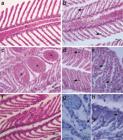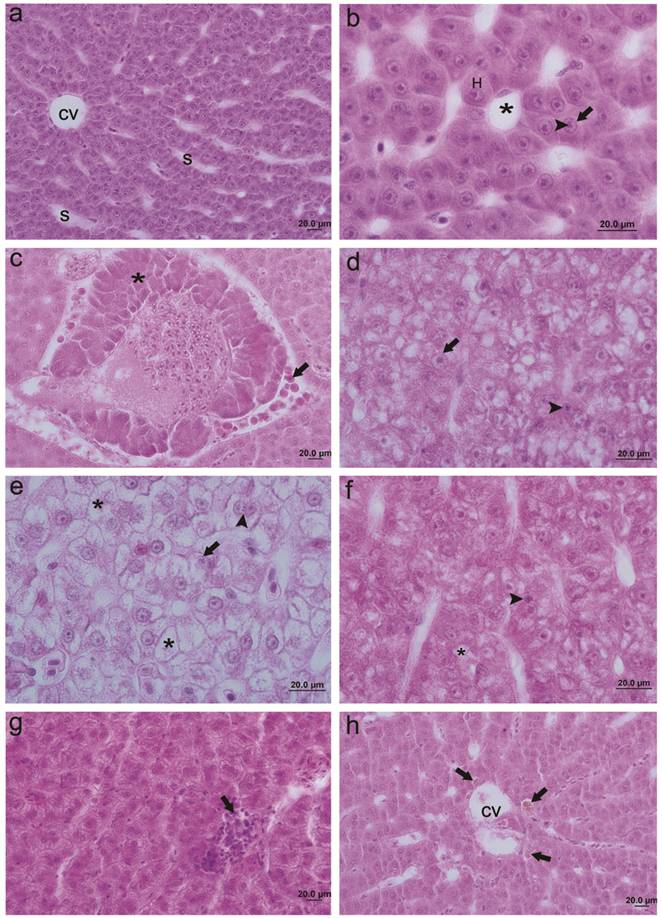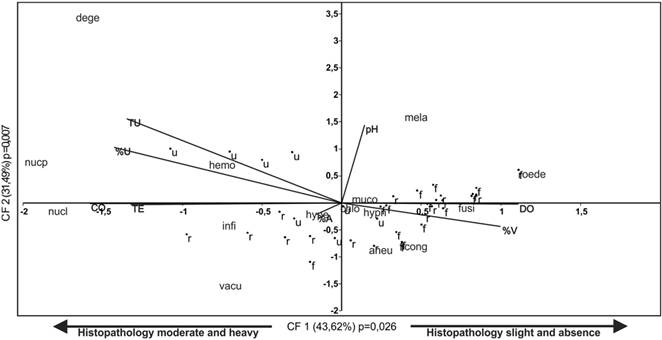| F1 (Lajeado stream) São José basin 2ª order |
53 |
47 |
0 |
Forest area composed of Mixed Ombrophilous Forest. Rural area composed of monocultures of corn and soybean (main agrochemicals - organophosphates and carbamates) (IBGE, 2015Instituto Brasileiro de Geografia e Estatística (IBGE)/ Coordenação de Recursos Naturais e Estudos Ambientais e Coordenação de Geografia. Indicadores de desenvolvimento sustentável: Brasil.. Rio de Janeiro: IBGE; 2015. (Estudos e pesquisas; Informação geográfica; No. 10).). |
25º02'24,8''S 53º20'35,9''W |
7,19±0,01bc
|
20,2±0,1a
|
7,3±0,1a
|
13,1±0,1e
|
3,14±0,01b
|
| F2 (Pedregulho stream) Arquimedes basin 2ª order |
75 |
25 |
0 |
Forest area composed of Mixed Ombrophilous Forest. Rural area composed of monocultures of corn and soybean (main agrochemicals - organophosphates and carbamates) (IBGE, 2015Instituto Brasileiro de Geografia e Estatística (IBGE)/ Coordenação de Recursos Naturais e Estudos Ambientais e Coordenação de Geografia. Indicadores de desenvolvimento sustentável: Brasil.. Rio de Janeiro: IBGE; 2015. (Estudos e pesquisas; Informação geográfica; No. 10).). |
25º06'06,2''S 53º18'39,8''W |
7,01±0,01ab
|
21,3±0,3ab
|
6,81±0,1b
|
27,8±1,1d
|
2,8±0,2c
|
| R1 (Cacula stream) Iguaçu basin 3ªorder |
18 |
78 |
4 |
Rural area composed of monoculture (corn and soybean). Main used pesticides (organophosphates and carbamates) (IBGE, 2015Instituto Brasileiro de Geografia e Estatística (IBGE)/ Coordenação de Recursos Naturais e Estudos Ambientais e Coordenação de Geografia. Indicadores de desenvolvimento sustentável: Brasil.. Rio de Janeiro: IBGE; 2015. (Estudos e pesquisas; Informação geográfica; No. 10).). Riparian forest area composed of secondary vegetation. |
25º31'15,2''S 53º36'03,3''W |
7,21±0,01bc
|
23,5±0,8c
|
5,77±0,1d
|
50,1±1,0c
|
2,1±0,1d
|
| R2 (Avenca stream) Macaco basin 3ª order |
31 |
69 |
0 |
Rural area composed of monoculture (corn and soybean). Main used pesticides (organophosphates and carbamates) (IBGE, 2015Instituto Brasileiro de Geografia e Estatística (IBGE)/ Coordenação de Recursos Naturais e Estudos Ambientais e Coordenação de Geografia. Indicadores de desenvolvimento sustentável: Brasil.. Rio de Janeiro: IBGE; 2015. (Estudos e pesquisas; Informação geográfica; No. 10).). Riparian forest area composed of secondary vegetation. |
25º21'48,7''S 53º10'19,3''W |
6,92±0,3ª |
24,2±1,1c
|
5,72±0,2d
|
67,9±1,5b
|
2,3±0,2d
|
| U1 (Aparecida stream) Monteiro Basin 3ª order |
19 |
40 |
41 |
Urban area with waterproofing of the soil and discharge of domestic sewage and water from galleries. Main pollutants present in sewage (drugs, oil, organic matter, insecticides) (Benatto et al., 2013Benatto A, Rubio C, Jesus DA, Goto DYN, Rubio G, Belmonte I et al., organizadores. Vigilância da saúde de populações expostas a agrotóxicos no Paraná. Curitiba: Secretaria do estado da saúde do Paraná (SESA); 2013.). Rural area composed of monoculture (corn and soybean). Main used pesticides (organophosphates and carbamates) (IBGE, 2015Instituto Brasileiro de Geografia e Estatística (IBGE)/ Coordenação de Recursos Naturais e Estudos Ambientais e Coordenação de Geografia. Indicadores de desenvolvimento sustentável: Brasil.. Rio de Janeiro: IBGE; 2015. (Estudos e pesquisas; Informação geográfica; No. 10).). |
25º28'31,2''S 53º36'52,9''W |
7,13±0,1bc
|
24,1±1,1c
|
5,61±0,1d
|
146,6±1,8a
|
2,24±0,1d
|
| U2 (Adelaide stream) Adelaide basin 2ª order |
21 |
48 |
31 |
Urban area with waterproofing of the soil and discharge of domestic sewage and water from galleries. Main pollutants present in sewage (drugs, oil, organic matter, insecticides) (Benatto et al., 2013Benatto A, Rubio C, Jesus DA, Goto DYN, Rubio G, Belmonte I et al., organizadores. Vigilância da saúde de populações expostas a agrotóxicos no Paraná. Curitiba: Secretaria do estado da saúde do Paraná (SESA); 2013.). Rural area composed of monoculture (corn and soybean). Main used pesticides (organophosphates and carbamates) (IBGE, 2015Instituto Brasileiro de Geografia e Estatística (IBGE)/ Coordenação de Recursos Naturais e Estudos Ambientais e Coordenação de Geografia. Indicadores de desenvolvimento sustentável: Brasil.. Rio de Janeiro: IBGE; 2015. (Estudos e pesquisas; Informação geográfica; No. 10).). |
25º12'15,3''S 53º08'56,6''W |
7,32±0,1c
|
22,9±1,1bc
|
6,2±0,1c
|
68,6±1,0b
|
10,8±0,3a
|
|
p value |
0,004 |
0,006 |
<0,0001 |
<0,0001 |
<0,0001 |
| F |
6,1537 |
5,6724 |
116,05 |
726,92 |
1591,8 |

 Thumbnail
Thumbnail
 Thumbnail
Thumbnail
 Thumbnail
Thumbnail
 Thumbnail
Thumbnail



